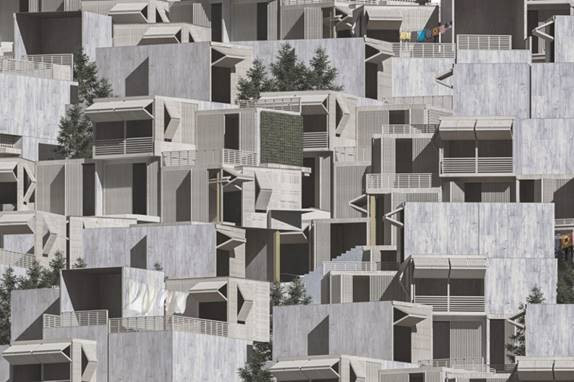City of Refugees
Of the 7.8 billion people on the planet, more than 70 million are now refugees and asylum seekers. With few countries willing to receive these displaced people, many refugees are restrained in tents, or makeshift cities. These temporary solutions often become permanent, which come with significant challenges. City of Refugees – a three-year research by the University of Houston College of Architecture and Design under the direction of the studio professors, Peter J. Zweig and Gail P. Borden – offers a provocative approach to the discussion of new solutions: Four imaginary cities on four continents were designed as prototypes for the accommodation of migrants providing facilities to meet their immediate needs and long-term opportunities for their self-empowerment. The exhibition at Aedes not only gives insights into the diverse aspects of these utopias, but also chronicles the plight and journeys of refugees in contemporary society.
The current global geopolitical landscape is indelibly marked by rising national and international conflicts creating multiple regions and countries beset by massive migrations. Likewise, the consequences of climate change and man-made environmental damage are forcing people to leave their homes. Many refugees are caught between borders because fewer countries are accepting the growing numbers. This often leads to them being trapped in refugee camps: Although these expanding settlements were intended as temporary tent communities, in reality they have become increasingly permanent.
Worth mentioning is the Kutupalong refugee camp in Bangladesh, which has existed since 1991. It has grown to become the largest of its kind in the world, with more than 600,000 people living in an area of just 13 square kilometres, stretching infrastructure and services to their limits. A more recent example of a permanent settlement is the Zaatari camp in Jordan where people have found refuge from the civil war in Syria since 2012. With an estimated 80,000 inhabitants, a main street with market stalls and shops, kindergartens and schools, solar power and a drinking water system, Zataari has become the fourth largest “city” in Jordan. However, the often forgotten, “temporary” communities are most often evolving into haphazard, ill-equipped, permanent locations that are in need of and reliant upon humanitarian support.
City of Refugees
A three-year intensive sequence of design studios at the University of Houston, Gerald D. Hines College of Architecture + Design, under the direction of Peter Jay Zweig, FAIA and Gail Peter Borden, FAIA has developed a provocative approach to proposing four prototypical Cities of Refugees of varying sizes on four continents, ranging from 50,000 to 500,000 people:
• BRIDGE CITY in South America
• RADIANT CITY in Africa
• SWITCHBACK CITY in Southeast Europe
• UPCYCLE CITY in South Asia
Each city is conceived as being universal in its architectural principles, yet by contrast, relies heavily upon local traditions whereby the residents of the City of Refugees are able to build their own homes: Thus combining universal and vernacular ideas can redefine the very origins of the contemporary city.
